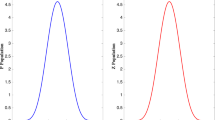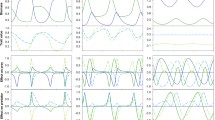Abstract
This paper explores how predator evolution and the magnitude of predator genetic variation alter the population-level dynamics of predator–prey systems. We do this by analyzing a general eco-evolutionary predator–prey model using four methods: Method 1 identifies how eco-evolutionary feedbacks alter system stability in the fast and slow evolution limits; Method 2 identifies how the amount of standing predator genetic variation alters system stability; Method 3 identifies how the phase lags in predator–prey cycles depend on the amount of genetic variation; and Method 4 determines conditions for different cycle shapes in the fast and slow evolution limits using geometric singular perturbation theory. With these four methods, we identify the conditions under which predator evolution alters system stability and shapes of predator–prey cycles, and how those effect depend on the amount of genetic variation in the predator population. We discuss the advantages and disadvantages of each method and the relations between the four methods. This work shows how the four methods can be used in tandem to make general predictions about eco-evolutionary dynamics and feedbacks.






Similar content being viewed by others
References
Abrams PA (1992) Adaptive foraging by predators as a cause of predator–prey cycles. Evol Ecol 6:56–72
Abrams PA (1999) The adaptive dynamics of consumer choice. Am Nat 153:83–97
Abrams PA (2001) Modelling the adaptive dynamics of traits involved in inter- and intraspecific interactions: An assessment of three models. Ecol Lett 4:166–175
Abrams PA (2005) Adaptive Dynamics’ vs. ‘adaptive dynamics. J Evolution Biol 18:1162–1165
Abrams PA (2006) Adaptive change in the resource-exploitation traits of a generalist consumer: the evolution and coexistence of generalists and specialists. Evolution 60:427–439
Abrams PA (2006) The effects of switching behavior on the evolutionary diversification of generalist consumers. Am Nat 168:645–659
Abrams PA, Kawecki TJ (1999) Adaptive host preferences and the dynamics of host-parasitoid interactions. Theor Popul Biol 56:307–324
Abrams PA, Matsuda H (1997) Fitness minimization and dynamic instability as a consequence of predator–prey coevolution. Evol Ecol 11:1–20
Abrams PA, Matsuda H (1997) Prey adaptation as a cause of predator–prey cycles. Evolution 51:1742–1750
Abrams PA, Matsuda H (2004) Consequences of behavioral dynamics for the population dynamics of predator–prey systems with switching. Popul Ecol 46:13–25
Abrams PA, Matsuda H, Harada Y (1993) Evolutionarily unstable fitness maxima and stable fitness minima of continuous traits. Evol Ecol 7:465–487
Abrams PA, Vos M (2003) Adaptation, density dependence and the responses of trophic level abundances to mortality. Evol Ecol Res 5:1113–1132
Agashe D (2009) The stabilizing effect of intraspecific genetic variation on population dynamics in novel and ancestral habitats. Am Nat 174:255–267
Arnold L, Jones CKRT, Mischaikow K, Raugel G (1995) Dynamical Systems, vol. 1609, chap. Geometric Singular Perturbation Theory, pp. 44–118. Springer, Heidelberg
Bassar RD, Marshall MC, López-Sepulcre A, Zandonà E, Auer SK, Travis J, Pringle CM, Flecker AS, Thomas SA, Fraser DF, Reznick DN (2010) Local adaptation in Trinidadian guppies alters ecosystem processes. Proc Nat Acad Sci 107:3616–3621
Becks L, Ellner SP, Jones LE, Hairston NG Jr (2010) Reduction of adaptive genetic diversity radically alters eco-evolutionary community dynamics. Ecol Lett 13:989–997
Bolnick DI, Amarasekare P, Araújo MS, Bürger R, Levine JM, Novak M, Rudolf VHW, Schreiber SJ, Urban MC, Vasseur DA (2011) Why intraspecific trait variation matters in community ecology. Trends Ecol Evol 26:183–192
Brodie ED III, Brodie ED Jr (1999) Costs of exploiting poisonous prey: evolutionary trade-offs in a predator–prey arms race. Evolution 53:626–631
Bulmer MG (1975) Phase relations in the ten-year cycle. J Anim Ecol 44(2):609–621
Bulmer MG (1976) The theory of prey–predator oscillations. Theor Popul Biol 9:137–150
Clark JS (2010) Individuals and the variation needed for high species diversity in forest trees. Science 327:1129–1132
Coberly LC, Wei W, Sampson KY, Millstein J, Wichman HA, Krone SM (2009) Space, time, and host evolution facilitate coexistence of competing bacteriophages: theory and experiment. Am Nat 173:E121–E138
Cortez MH (2011) Comparing the qualitatively different effects rapidly evolving and rapidly induced defences have on predator-prey interactions. Ecol Lett 14:202–209
Cortez MH (2015) Coevolution-driven predator–prey cycles: predicting the characteristics of eco-coevolutionary cycles using fast-slow dynamical systems theory. Theor Ecol 8:369–382
Cortez MH (2016) How the magnitude of prey genetic variation alters predator-prey eco-evolutionary dynamics. Am Nat 188:329–341
Cortez MH, Ellner SP (2010) Understanding rapid evolution in predator–prey interactions using the theory of fast-slow dynamical systems. Am Nat 176:E109–E127
Cortez MH, Weitz JS (2014) Coevolution can reverse predator–prey cycles. Proc Nat Acad Sci USA 111(20):7486–7491
Coutinho RM, Klauschies T, Gaedke U (2016) Bimodal trait distributions with large variances question the reliability of trait-based aggregate model. Theo Ecol 9:398–408
Crutsinger GM, Collins MD, Fordyce JA, Gompert Z, Nice CC, Sanders NJ (2006) Plant genotypic diversity predicts community structure and governs an ecosystem process. Science 313:966–968
Dieckmann U, Law R (1996) The dynamical theory of coevolution: a derivation from stochastic ecological processes. J Math Biol 34:579–612
Doebeli M (1997) Genetic variation and the persistence of predator–prey interactions in the Nicholson–Bailey model. J Theor Biol 188:109–120
Doebeli M, Blok HJ, Leimar O, Dieckmann U (2007) Multimodal pattern formation in phenotype distributions of sexual populations. Proc R Soc Lond B Biol Sci 274:347–357
Ellner SP, Becks L (2011) Rapid prey evolution and the dynamics of two-predator food webs. Theor Ecol 4:133–152
Falconer DS, Mackay TFC (1996) Introduction to quantitative genetics, 4th edn. Longman, Essex
Fussmann GF, Loreau M, Abrams PA (2007) Eco-evolutionary dynamics of communities and ecosystems. Funct Ecol 21:465–477
Geritz SAH, Kisdi É, Meszéna G, Metz JAJ (1998) Evolutionarily singular strategies and the adaptive growth and branching of the evolutionary tree. Evol Ecol 12:35–57
Hiltunen T, Becks L (2014) Consumer co-evolution as an important component of the eco-evolutionary feedback. Nat Commun 5:5226
Hiltunen T, Hairston NG Jr, Hooker G, Jones LE, Ellner SP (2014) A newly discovered role of evolution in previously published consumer-resource dynamics. Ecol Lett 17:915–923
Hughes AR, Inouye BD, Johnson MTJ, Underwood N, Vellend M (2008) Ecological consequences of genetic diversity. Ecol Lett 11:609–623
Imura D, Toquenaga Y, Fujii K (2003) Genetic variation can promote system persistence in an experimental host-parasitoid system. Popul Ecol 45:205–212
Johnson MTJ, Vellend M, Stinchcombe JR (2009) Evolution in plant populations as a drive of ecological changes in arthropod communities. P R Soc Lond B Bio 364:1593–1605
Jones LE, Becks L, Ellner SP, Hairston NG Jr, Yoshida T, Fussmann GF (2009) Rapid contemporary evolution and clonal food web dynamics. Philos T Roy Soc B 364(1523):1579–1591
Jones LE, Ellner SP (2007) Effects of rapid prey evolution on predator–prey cycles. J Math Biol 55:541–573
Kinnison MT, Hairston NG Jr (2007) Eco-evolutionary conservation biology: contemporary evolution and dynamics of persistence. Funct Ecol 21:444–454
Kondoh M (2003) Foraging adaptation and the relationship between food-web complexity and stability. Science 299(5611):1388–1391
Lande R (1976) Natural selection and random genetic drift in phenotypic evolution. Evolution 30:314–334
Lande R (1982) A quantitative genetic theory of life history evolution. Ecology 63:607–615
Lankau R, Strauss SY (2007) Mutual feedbacks maintain both genetic and species diversity in a plant community. Science 317:1561–1563
Levin S, Udovic J (1977) A mathematical model of coevolving populations. Am Nat 111:657–675
Ma BO, Abrams PA, Brassil CE (2003) Dynamic versus instantaneous models of diet choice. Am Nat 162:668–684
Marrow P, Dieckmann U, Law R (1996) Evolutionary dynamics of predator–prey systems: an ecological perspective. J Math Biol 34:556–578
Mougi A (2010) Coevolution in a one predator-two prey system. PLoS One 5:e13,887
Mougi A (2012) Predatorprey coevolution driven by size selective predation can cause anti-synchronized and cryptic population dynamics. Theor Popul Biol 81:113–118
Mougi A (2013) Allelopathic adaptation can cause competitive coexistence. Theor Ecol 6:165–171
Mougi A (2015) Coevolution can stabilize a mutualistic interaction. Evol Ecol 30:365–377
Mougi A, Iwasa Y (2010) Evolution towards oscillation or stability in a predator prey system. Proc R Soc B 277:3163–3171
Mougi A, Iwasa Y (2011) Unique coevolutionary dynamics in a predator–prey system. J Theor Biol 277:83–89
Palkovacs EP, Post DM (2009) Experimental evidence that phenotypic divergence in predators drives community divergence in prey. Ecology 98:300–305
Patel S, Schreiber SJ (2015) Evolutionary-driven shifts in communities with intraguild predation. Am Nat 186:E98–E110
Saloniemi I (1993) A coevolutionary predator–prey model with quantitative characteristics. Am Nat 141:880–896
Schreiber SJ, Bürger R, Bolnick DI (2011) The community effects of phenotypic and genetic variation within a predator population. Ecology 92:1582–1593
Shaw RG, Wagenius S, Geyer CJ (2015) The susceptibility of echinacea angustifolia to a specialist aphid: eco-evolutionary perspective on genotypic variation and demographic consequences. J Ecol 103:809–818
Tien RJ, Ellner SP (2012) Variable cost of prey defense and coevolution in predator–prey systems. Eco Monogr 82:491–504
Turelli M, Barton NH (1994) Genetic and statistical analyses of strong selection on polygenic traits: what, me normal? Genetics 138:913–941
Utsumi S (2015) Feeding evolution of a herbivore influences an arthropod community through plants: implications for plant-mediated eco-evolutionary feedback loop. J Ecol 103:829–839
Vasseur DA, Amarasekare P, Rudolf VHW, Levine JM (2011) Eco-evolutionary dynamics enable coexistence via neighbor-dependent selection. Am Nat 178:E96–E109
Vos M, Kooi BW, DeAngelis DL, Mooij WM (2004) Inducible defences and the paradox of enrichment. Oikos 105:471–480
Vos M, Verschoor AM, Kooi BW, Wäckers FL, DeAngelis DL, Mooij WM (2004) Inducible defenses and trophic structure. Ecology 85(10):2783–2794
Yamamichi M, Ellner SP (2016) Antagonistic coevolution between quantitative and Mendelian traits. Proc R Soc B 283:20152,926
Yamamichi M, Meunier CL, Peace A, Prater C, Rúa MA (2015) Rapid evolution of a consumer stoichiometric trait destabilizes consumer-producer dynamics. Oikos 124:690–969
Yoshida T, Ellner SP, Jones LE, Bohannan BJM, Lenski RE, Hairston NG Jr (2007) Cryptic population dynamics: rapid evolution masks trophic interactions. PLoS Biol 5(9):1–12
Yoshida T, Jones LE, Ellner SP, Fussmann GF, Hairston NG Jr (2003) Rapid evolution drives ecological dynamics in a predator–prey system. Nature 424:303–306
Acknowledgements
SP was supported by the American Association of University Women Dissertation Fellowship to SP and the Austrian Science Fund (FWF) Grant P25188-N25 awarded to Reinhard Burger at the University of Vienna.
Author information
Authors and Affiliations
Corresponding author
Electronic supplementary material
Below is the link to the electronic supplementary material.
Rights and permissions
About this article
Cite this article
Cortez, M.H., Patel, S. The Effects of Predator Evolution and Genetic Variation on Predator–Prey Population-Level Dynamics. Bull Math Biol 79, 1510–1538 (2017). https://doi.org/10.1007/s11538-017-0297-y
Received:
Accepted:
Published:
Issue Date:
DOI: https://doi.org/10.1007/s11538-017-0297-y




